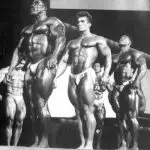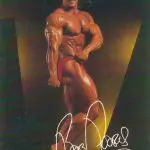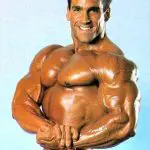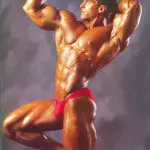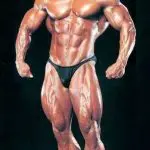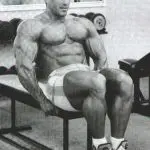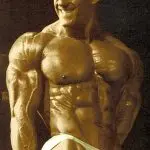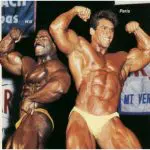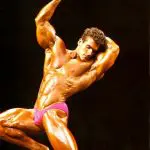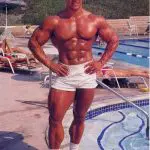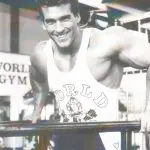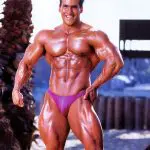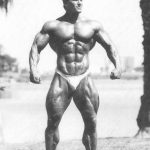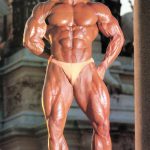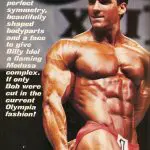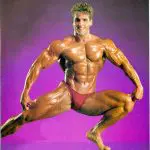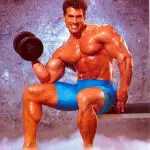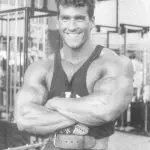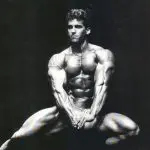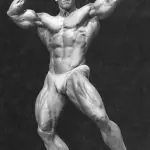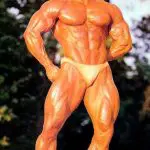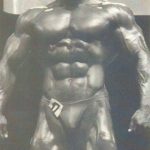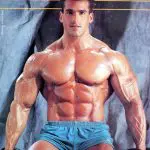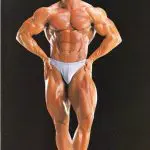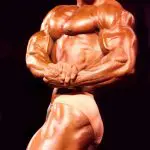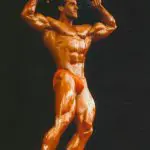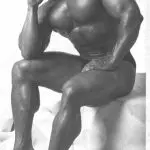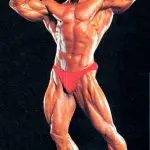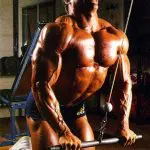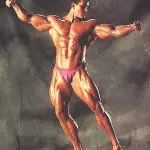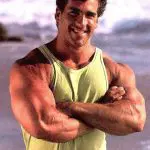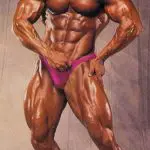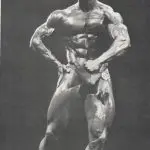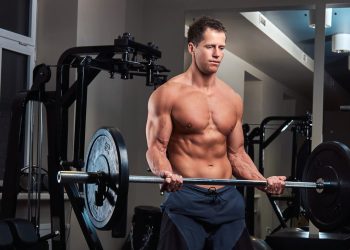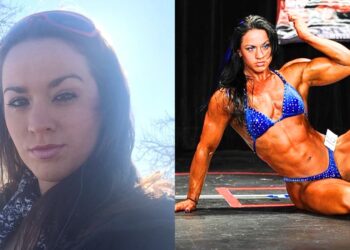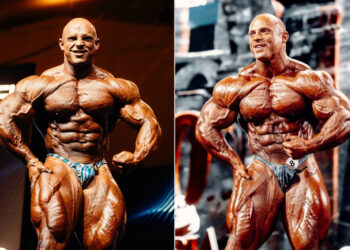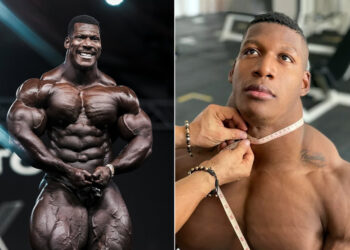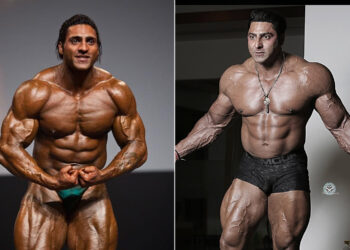Bob Paris is a retired Canadian-American bodybuilder who has worked in several other fields. He competed in the 1980s and 1990s era of bodybuilding and participated in the Mr. Olympia competition several times. Although he never won any major bodybuilding titles, he is remembered for having one of the most aesthetic physiques of his era.
Paris refused to sacrifice aesthetics and chase size, which was becoming a new normal during the peak of his activity level. While this affected his competitive career and cost him the championship titles, he undeniably set a positive example to follow for young bodybuilders. In this article, we explore his biography, competition history, workout routine, and diet.
Bob Paris (The Flawless Marvel)
Born: December 14, 1959
Birthplace: Columbus, Indiana, USA
Residence: Los Angeles, California, USA
Nickname: The Flawless Marvel
Height: 5′ 10″ (180 cm)
Competition Weight: 229 lbs (104 kg)
View this post on InstagramGet Fitter, FasterLevel Up Your Fitness: Join our 💪 strong community in Fitness Volt Newsletter. Get daily inspiration, expert-backed workouts, nutrition tips, the latest in strength sports, and the support you need to reach your goals. Subscribe for free!
Bob Paris Biography
Early Life
Bob Paris was born on December 14, 1959, in Columbus, Indiana. He was an active kid while growing up and enjoyed painting and writing as much as outdoor activities like hiking, canoeing, and cycling.
He excelled in acting as well and performed in several musicals in theater. But while he was pursuing sports like football, track and field, or golf, Bob Paris turned to the weight room to get strong and fit.
The Indiana native soon developed a passion for bodybuilding and realized that he had a genetic gift to pursue the craft as much as other sports.
Bodybuilding Career
When Bob Paris finished college and returned to his home in Indiana, differences with his father led to him being thrown out of the house and he shifted to Santa Monica. Initially, Paris struggled to survive and did odd jobs to get by. However, he continued training to pursue a bodybuilding career.
Soon, Bob Paris won the 1981 Mr. Los Angeles competition and performed well at the 1982 Mr. California and the 1982 NPC National Championships. The Indiana Native started gaining momentum and eventually earned his IFBB Pro card with a win at the 1983 NPC National Championships. He won the competition in the heavyweight division and also became the overall winner.
Bob Paris made his Mr. Olympia debut in 1984 with a seventh-place finish. This proved to be his best performance on the grandest stage of bodybuilding as Paris could never place higher in any of his subsequent appearances.
In his 11-year-long bodybuilding career, the American bodybuilder achieved several third-place finishes but unfortunately, he never won a pro show. He retired from the competition after a 10th-place finish at the 1992 Chicago Pro Invitational.
Competition History
- 1981 NPC Mr. Los Angeles, Light-heavyweight class and Overall – 1st place
- 1982 NPC Mr. Southern California, Light-heavyweight class and Overall – 1st place
- 1982 NPC California Muscle Classic, Light-heavyweight class and Overall – 1st place
- 1982 NPC Mr. California, Light-heavyweight class – 2nd
- 1982 NPC American National Championships [Mr. America] (New York City), Heavyweight class – 3rd place
- 1983 NPC National Championships, Heavyweight class and Overall – 1st place
- 1983 IFBB World Championships, Heavyweight class and Overall – 1st place
- 1984 Mr. Olympia – 7th place
- 1985 Mr. Olympia – 9th place
- 1986 IFBB Los Angeles Pro Championships – 7th place
- 1986 IFBB World Pro Championships – 6th place
- 1988 IFBB Chicago Pro Invitational – 5th place
- 1988 Gran Prix England – 6th place
- 1988 Gran Prix France – 4th place
- 1988 Gran Prix Germany – 6th place
- 1988 Gran Prix Greece – 6th place
- 1988 Gran Prix Italy – 3rd place
- 1988 Gran Prix Spain – 5th place
- 1988 Gran Prix Spain (2) – 4th place
- 1988 Niagara Falls Pro Invitational – 3rd place
- 1988 Night of Champions – 3rd place
- 1988 Mr. Olympia – 10th place
- 1989 Arnold Classic – 5th place
- 1989 IFBB Grand Prix France – 3rd place
- 1989 Gran Prix Germany – 6th place
- 1989 Gran Prix Melbourne – 3rd place
- 1989 Gran Prix Spain – 3rd place
- 1989 Gran Prix Spain (2) – 3rd place
- 1989 Gran Prix Sweden – 4th place
- 1989 IFBB Night of Champions – 4th place
- 1989 Mr. Olympia – 14th place
- 1989 IFBB World Pro Championships – 3rd place
- 1990 IFBB Night of Champions – 14th place
- 1991 Arnold Classic – 16th place
- 1991 IFBB Grand Prix Italy – 5th place
- 1991 Ironman Pro Invitational – 10th place
- 1991 Musclefest Grand Prix – 3rd place
- 1991 Mr. Olympia – 12th place
- 1992 IFBB Mr. Chicago Pro Invitational – 10th place
Bob Paris Workout
During his active bodybuilding days, Bob Paris refused to participate in the size game that was increasingly taking center stage in the competitive sphere. Freakish physiques with incredible muscle mass were becoming the new normal then, but Paris never went in that direction.
He added muscle mass only to an extent where his physique was aesthetically pleasing with the right amount of muscle definition and cuts at the correct locations. Not surprisingly, this is also the core value of his workout routine as well.
Paris believed in setting an aesthetic goal before starting the training journey. Once you have an idea about how you want your physique to look, it should be easier to formulate a workout routine to help you achieve that look. Plus, the physique goal would become a huge motivation for training.
The veteran bodybuilder thinks that once you formulate a training plan for your target physique, working on the lagging parts should take the lead. He made these as the smaller immediate goals that would deliver the results for the larger goal to be achieved in due time.
“If you want an aesthetic body, a work of sculpture made of flesh, focus on aesthetics first and foremost.”
There are several schools of thought and belief systems in the bodybuilding sphere. Many elite bodybuilders and experts have contradicting opinions on factors like ideal rep range and exercise sequence, to name a few.
But Bob Paris did not restrict himself to following a particular method with rigidity. Instead, he used all kinds of rep ranges to get the most out of his training.
Paris went anywhere from 6 to 25 reps in a set depending upon the muscle group targeted, the weight used, and the immediate fitness goal. For example, the veteran bodybuilder generally maintained a 10 to 12 rep range but performed a few heavier sets in the 6 to 8 range. Meanwhile, for smaller muscles like calves, abs, and arms, he followed a higher rep range (12 to 15 or 15 to 25).
“Changing up the reps keeps me motivated with different goals—more weight with lower reps or more reps with less weight; and it’s another way of varying the stress on my muscles.”
Cardio and rest days
Bob Paris believes in the benefits of cardio training for burning calories and strengthening the cardiovascular system. He trains cardio every day and seldom skips doing it. The veteran bodybuilder prefers doing 20 to 30 minutes of cardio at the end of his workouts. The treadmill, stationary bike, or stepmill are his go-to cardio equipment. The American bodybuilder has a simple philosophy when it comes to off days/rest days:
“I don’t want to have a day when I’m off my goals, when I do nothing and eat junk. There’s no off for my goals. They’re always on. I’m still working towards my goals on my active rest days, still doing cardio, still eating right, and doing things like stretching and massage to aid workout recovery.”
As a result, he never takes complete off days. Instead, he keeps the body moving with active recovery and cardio exercises.
Bob Paris Workout Split
Bob Paris followed a six-day training routine per week. He followed the push-pull-leg day workout split and trained every muscle group twice a week. The veteran bodybuilder finished the push-pull-leg circuit in the first three days. He then took a day off for active recovery and repeated the routine. However, the exercise selection and sequence in the second set of push-pull-day sessions were slightly different from the first three days.
Day 1 – Push Day, Abs, and Cardio
Bob Paris performed several compound and isolation exercises targeting the chest, shoulders, and triceps on a push day. To increase the aerobic intensity of the workout and push his limits, the veteran bodybuilder used techniques like supersets along with straight sets.
Paris has always been conscious about prioritizing the upper chest muscles in the training routine. Most people struggle to bring this part of the physique to par with the rest. This can often lead to the chest looking ‘droopy’ due to the lower pecs being overdeveloped in comparison with the upper pecs.
Level Up Your Fitness: Join our 💪 strong community in Fitness Volt Newsletter. Get daily inspiration, expert-backed workouts, nutrition tips, the latest in strength sports, and the support you need to reach your goals. Subscribe for free!
Bob Paris said about his chest training principles:
“I focus mostly on the upper part with incline presses and incline flyes, four sets of each and I do them first. Then I’ll end my chest routine with flat dumbbell presses and dumbbell pullovers for three sets each. So it’s mostly about the upper pecs, and I like to end with dumbbell pullovers for higher reps [15-20] to work my serratus and tie the pecs and lats together.”
Like the upper pecs, the Canadian-American bodybuilder also approaches the lateral delts strategically. Aesthetically, the lateral/medial delts give the broad shoulder look to the upper body that most people desire.
Chances are that most people will have overdeveloped anterior delts because the muscle gets activated during most pushing exercises. Comparatively, lateral delts would only come up if targeted with specific isolation movements.
Therefore, Paris prefers starting the shoulder workout with lateral delt movements and follows them up with rear delt-focused exercises. He saves the anterior deltoid exercises for the last.
A typical push day session in his training routine looked like this:
- Incline Bench presses 4 sets 6-8 reps
- Incline Flyes 4 sets 12-15 reps
- Flat Dumbbell Presses 3 sets 6-8 reps
- Across Bench Pull-overs 3 sets, 15-20 reps
- Dumbbell Side Raises 4 sets 10-12 reps
- Rear Pulley Crunches 4 sets 6-8 reps
- Barbell Presses 4 sets 6-8 reps
- Bench Dips 4 sets 15-20 reps
- Push-downs 4 sets 6-8 reps
- Two Dumbbell Kickbacks 3 sets, 10-12 reps
- Hanging Leg Raises 3 sets 15-20 reps (tri-set)
- Lying leg raises 3 sets 15-20 reps(tri-set)
- Crunches 3 sets 15-20 reps (tri-set)
- Cardio 20-30 minutes (bike or stair stepper)
Day 2 – Legs and Cardio
Paris performed several isolation and compound exercises to work the lower body muscles. But unlike most bodybuilders, he preferred front squats over back squats. ‘The Flawless Marvel’ feels that front squats direct a majority of the stimulus towards quads and it is relatively easier for him to maintain an upright posture during the front squats.
“When I do back squats, I like a block under my heels to help me stay upright.”
Bob Paris always paid attention to calves and trained them at least twice every week. He performed standing and seated calf raises as well as calf presses to develop these muscles. But most importantly, the veteran bodybuilder focused on working the tibia.
“Developing the tibia gives your calves some depth from the front, and it also protects against shin splints if you do any running.”
A typical leg day training session consisted of the following exercises:
- Leg Extensions 4 sets 15-20 reps
- Front Squats 4 sets 12-15 reps
- Lunges 4 sets 10-12 reps
- Lying Leg curls 4-5 sets
- Stiff- Leg Deadlifts 4-5 sets, 12-15 reps
- Standing Calf Raises 3-4 sets 20-25 reps
- Tibia Raises 3-4 sets 20-25 reps
- Cardio 20-30 minutes
Day 3 – Pull Day and Forearms
Bob Paris included many compound and isolation movements to target the upper posterior chain of muscles and biceps on a pull day. He feels that some bodybuilders undertrain the traps due to the fear that it might make their shoulders look narrower. However, Paris believes that fully developed traps give you a complete look, and suggests training them with exercises like shrugs and rack pulls.
The pull day consisted of the following exercises:
- Wide Grip Pulldowns 4 sets 12 -15 reps
- Close Grip Pulldowns 4 sets 8 -10 reps
- One Dumbbell Rows 4 sets, 10 -12 reps
- Half Deadlift/ Shrugs 3 sets, 8 -10 reps
- Hyperextensions 3 sets, 20 -25 reps
- Incline Dumbbell Curls 4 sets, 10 -12 reps
- Barbell Curls 3 – 4 sets, 8 -10 reps
- One arm Pulley Curls 3 sets, 12 -15 reps
- Pulley Compound Wrist Curls 3 sets, 12 -15 reps
Day 4 – Rest, Cardio
Cardio 20-30 minutes
Day 5 – Push Day and Cardio 2
- Bench Press 4 sets 6-8 reps
- Incline Dumbbell Presses 4 sets 8-10 reps
- Cable Crossovers 3 sets, 15-20 reps
- Across – Bench Pullovers 3 sets 12-15 reps
- Dumbbell Presses 4 sets 6-8 reps
- Bent-over side Raises 4 sets 10-12 reps
- Lying Compound side Raises 4 sets 10-12 reps
- Rope Push Down 4 sets 6-8 reps
- Overhead Pulley Extensions 4 sets 12- 15 reps
- Lying French Press 3 sets 15-20 reps
- Hanging leg Raises 3 sets 12-15 reps
- Lying leg Raises 3 sets 12-15 reps
- Crunches 3 sets 12-15 reps
- Cardio 20-30 minutes
Day 6 – Legs and Cardio 2
- Hack Squats 4 sets, 12-15 reps
- 45- Degree Leg Presses 3 sets, 15-20 reps
- Leg Extension 4 sets 15-20 reps
- Standing Leg Curls 4 sets, 12-15 reps
- Lying leg curls 4 sets,10-12 reps
- Leg-Press Calf Raises 4 sets 10-12 reps
- Seated Calf Raises 3 sets 10-12 reps
- Tibia Raises 3 sets, 15-20 mins
- Cardio 20-30 mins
Day 7 – Pull Day and Forearms 2
- Wide Rear Pull Downs 5 sets,15-20 reps
- Low Pulley Rows 4 sets, 6-8 reps
- T-Bar Rows 4 sets, 8-10 reps
- Dumbbell Shrugs 4 sets, 20-25 reps
- Hyperextensions 4 sets, 20-25 reps
- Concentration curls 4-5 sets, 6-8 reps
- Barbell Preacher Curls 4 sets,6-8 reps
- Zottman Curls 4 sets 12-15 reps
- Barbell Wrist Curls 4 sets 15-20 reps
Bob Paris Diet
Bob Paris firmly believed that an aesthetically perfect and muscular physique is a by-product of good health and fitness. He believes that as long as you eat healthy, rest well, and train consciously, the body will transform itself to become well-proportioned and aesthetically pleasing.
Paris kept things simple on the diet side of things. He followed a nutrient-dense whole-food diet that was balanced in terms of macronutrient profile. He ate lean meats, healthy portions of vegetables and fruits as well as milk products to meet the daily nutrition requirements.
At the peak of his bodybuilding career, Bob Paris ate five to six meals per day. Here is an example of his full day of eating to build and sustain an incredibly muscular physique:
Meal 1
- 5 ounces ground beef or steak
- 5 ounces lima beans or chickpeas
- 4 ounces rice
- 3 ounces spinach
Meal 2
- One whole egg
- 7 egg whites
- 4 ounces oatmeal
- 4 ounces of non-fat milk
Meal 3
- 5 ounces turkey or chicken breast
- 5 ounces roasted corn or potato
- 5 ounces green peas or string beans
- 5 ounces brussels sprouts / spinach / broccoli
Meal 4
- 5 ounces scallops
- 5 ounces steak
- 5 ounces sweet potato
- 3 ounces broccoli
- 5 ounces zucchini or eggplant
Meal 5
- 4 ounces cod
- 10 ounces baked potato
- One whole egg
- Asparagus
Personal Life
Bob Paris is regarded as the first male professional athlete to come out as being gay while still being an active competitor. He revealed his sexuality in a 1989 issue of Ironman magazine.
He was in a relationship with his boyfriend Rod Jackson at the time of this revelation. However, the couple split after being together for seven years.
Bob Paris has been married to his husband, Brian LeFurgey, since 2003. The couple lives on an island near Vancouver, British Columbia.
To Conclude…
The simplicity and straightforwardness in Bob Paris’ approach to bodybuilding training and diet shows that you don’t have to do something revolutionary or out of the norm to get better. Sometimes, adhering to the basics with discipline and commitment can take you to the destination just as well.

